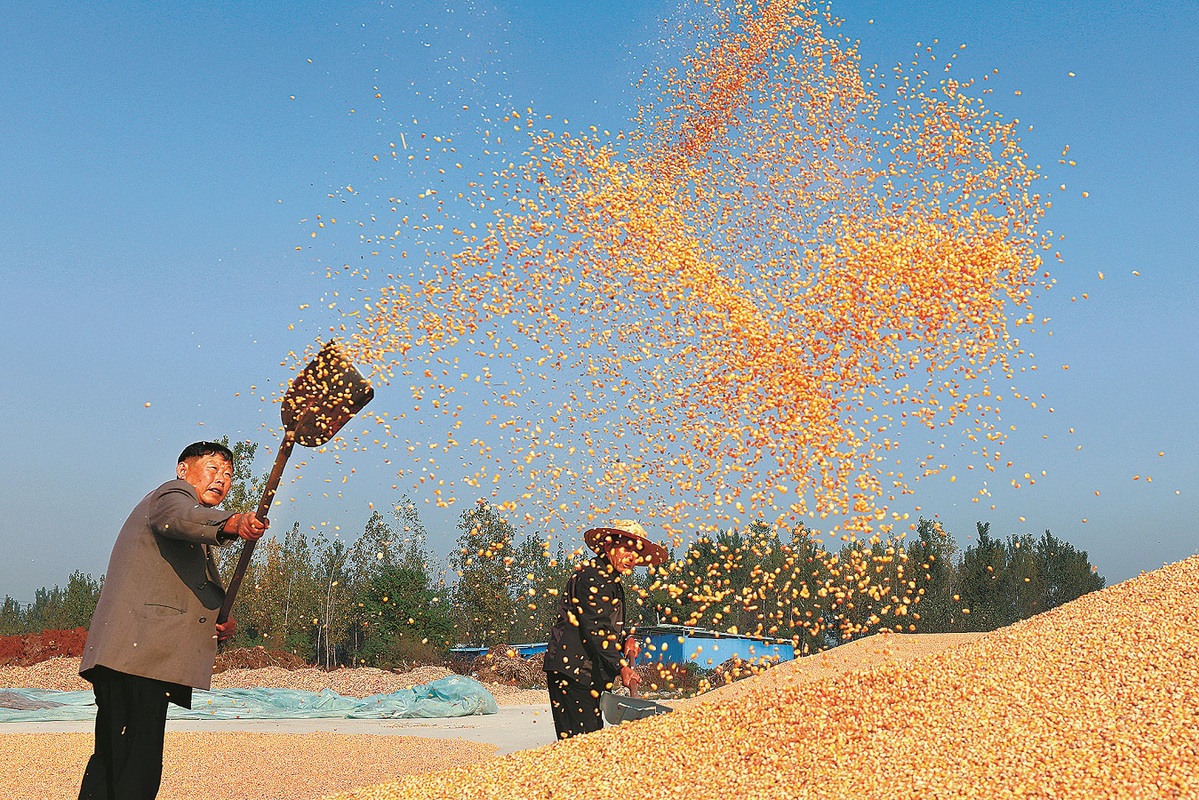Grain output rises despite disruptions

Farmers shovel corn for air-drying in Zaozhuang, Shandong province, in October. SUN ZHONGZHE/FOR CHINA DAILY
Total, per-hectare yields both increase after relief efforts on drought, flood
China's grain output this year has surged more than 1 percent year-on-year despite a string of destructive heatwaves and torrential rains in the lead-up to the autumn harvest, official figures showed.
Officials noted that a larger growing area, the adoption of high-yield crop varieties and milder-than-usual droughts are among the reasons.
The nation produced 695.41 million metric tons of grain this year, about 8.88 million tons, or 1.3 percent, more than in 2022, the National Bureau of Statistics said on Monday.
The total food growing area spanning the country's 31 provincial-level administrative regions added up to 119 million hectares and is 0.5 percent larger than last year, the bureau said in a statement.
Food productivity averaged 5.84 tons per hectare across the nation, which is 0.8 percent higher than last year, it said.
This was the ninth year that the national food yield has surpassed 650 million tons, a benchmark set out in the annual central government reports in recent years to ensure national food security.
The expanded food yield follows a host of extreme weather events that had disrupted food production in a number of areas known as the country's "grain barns".
That includes severe floods in August, which inundated large swaths of fertile black soil in Wuchang, Northeast China's Heilongjiang province. Large areas of maturing rice crops were wiped out less than a month before harvest season.
Zeng Yande, who oversees agricultural development and planning at the Ministry of Agriculture and Rural Affairs, said that apart from certain disaster-afflicted areas, most grain-producing regions would churn out more food due to a good mix of sunlight, suitable temperatures and rainfall.
The figures from the ministry showed about 9.6 million hectares of crops were affected by typhoons, droughts, floods, frost and heatwaves this year.
However, that was 1.9 million hectares fewer than the previous year, and 7.2 million hectares fewer than the five-year average.
Drought-affected crop fields made up 30 percent of all disaster-affected farmland this year, lower than the 42 percent average.
Pan Wenbo, director of the ministry's planting management department, said at the news conference, "Practices have shown that wetter years such as this year are conducive for food production."
Efforts by authorities to promote high-yield corn and soybean varieties, and earmarked disaster-relief funds also contributed to the rise, agricultural officials said.
Authorities this year launched a campaign to bolster productivity in 200 corn-growing counties, and 100 soybean-growing counties, through methods ranging from promoting varieties that can be planted more densely, to stepping up crop management efforts to prevent diseases and pest-induced damage.
In September, the ministries of finance and agriculture earmarked 1 billion yuan ($139 million) to help tackle the agricultural fallout of natural disasters and control pest and crop diseases.
About 357 million yuan went to flood-ravaged provinces in Northeast China, the ministries said.
Photos
Related Stories
- Chinese FM pledges enhanced educational, agricultural cooperation with Mali
- Chinese scientists discover genetic secret of iron-rich maize
- China releases first pan-genome map of tea plant
- From space to plate: Vegetable cultivation yields good harvest on Shenzhou-17
- BRI agricultural cooperation help alleviate hunger in less developed countries: report
- Chinese university shares agricultural technology with Myanmar
Copyright © 2023 People's Daily Online. All Rights Reserved.









